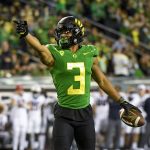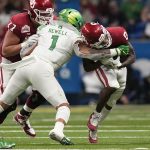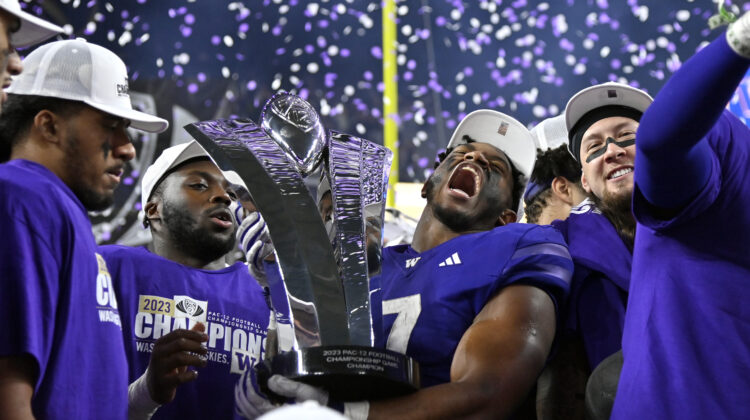The Hotline mailbag publishes weekly. Send questions to pac12hotline@
Please note: Some questions have been edited for clarity and brevity.
Which of the former Pac-12 schools entering the Big Ten would you expect to have the most football wins over the next five or 10 years? — @CreedThoughts24
It’s a fascinating topic that is more easily addressed if we work in reverse order.
Of the four, UCLA has the most challenging road and, in our view, will win the fewest games — whether the timeframe is five years, 10 years or a quarter century.
There are a plethora of reasons, including the primacy of basketball within the athletic culture. But everything starts with tangible evidence: The Bruins have been less successful than USC, Oregon and Washington in the Pac-12 over the past three decades, and life will get exponentially more difficult in the Big Ten.
Football success will require a greater institutional commitment and greater allocation of resources. Are the Bruins willing to take the necessary steps? (It depends, to an extent, on the preferences of the next chancellor.)
From there, we view Washington as a rung above UCLA on the success ladder but below USC and Oregon, for many of the same reasons: The Huskies don’t carry the same institutional commitment to winning as Oregon and USC.
In fact, you could argue that Washington and UCLA have more in common with each other than either does with its rival.
The Huskies have been more successful this century than UCLA, of course. But from outside the university walls, it appears that both schools are hesitant to go all-in with football when it comes to recruiting, admissions, staff salaries, facilities, amenities and all arms of the university pushing in the same direction.
(That approach isn’t necessarily wrong, but it makes winning consistently more challenging.)
So we’re left with Oregon and USC. Which school will win more games in the Big Ten?
Oregon and Washington are half-share members of the Big Ten for the next six years, meaning they will receive approximately $180 million less in conference distributions than USC and UCLA, which are full-share members.
But Oregon has the support, thanks largely to Phil Knight, to offset the difference in revenue.
And of the two programs, the Ducks are clearly better positioned for initial success in the Big Ten — they have a roster capable of competing with Ohio State for the conference title in the fall. USC does not.
But over the span of five or 10 years, the outlook isn’t as clear.
Much hinges on the caliber of the head coaches at the respective schools. How long will Dan Lanning stay in Eugene? Will Lincoln Riley fortify his defense and remain with the Trojans?
And if either leaves, is his replacement sufficient?
Both schools will have the Big Ten platform. Both will have the resources needed. Both are terrors on the recruiting trail. Both will treat athletes as employees if (when) the NCAA shifts to a professional model. And both would clear the bar for entry into any type of super league that arises.
The primary difference between the trajectories of the two programs in the new era could depend on something as traditional as the head coach.
What’s the latest on the ACC saga and its potential impact? — @CelestialMosh
We have reached the boring stage of the ACC’s internecine legal fight — after the initial filings by Florida State, Clemson and the conference but before any type of resolution. The parties are exchanging motions and filings, a process that could last months.
A settlement is the most likely and logical outcome. The ACC has no plans to back down, while the schools seemingly are beyond the point of returning to their previous existence as willing and satisfied members of the conference.
That said, ACC schools must declare their membership this summer for the 2025-26 academic year. So there’s a chance (albeit slim) the situation gets resolved in a few months.
Several West Coast schools could be impacted.
Yes, Washington State and Oregon State are rooting for chaos, for a breakup of the ACC. Another realignment wave could offer them a path to the same competitive tier as the outbound Pac-12 schools.
Stanford and Cal are deeply involved, as well, after signing contracts with the ACC through the 2035-36 academic year.
If the conference fractures, the Bay Area schools would need new homes. Rebuilding the Pac-12 with WSU and OSU would be an option.
How much do the conferences or the universities consider audiences overseas in their media deals? — @KyleAlves6
The Pac-12 spent considerable time and resources on building its presence in China. We saw how that turned out.
The two healthiest, wealthiest conferences, the Big Ten and SEC, don’t spend two seconds on overseas endeavors of any significance — they are wholly focused on maximizing their product domestically.
Why should anyone else?
What are your thoughts on Richard Lyons, Cal’s new chancellor, as it relates to intercollegiate athletics? — @alflorit
Far too early to draw any conclusions, other than the UC regents’ decision could have been worse.
An academic with no connections in the Cal community would have been less likely to value athletics than an academic who undoubtedly has interacted with some members of the pro-athletics crowd. (Lyons is the former dean of Cal’s business school.)
At least, that’s our view.
Beyond support in the short term, however, the broader question doubles as the existential issue in Berkeley: Will the school embrace athletes as employees when that NCAA change becomes official in a few years?
If not, the Bears stand no chance of competing at the highest tier, particularly in football.
Now that the Pac-12 lawsuit is settled, what’s next for Washington State and Oregon State? — @WebGuy223
What’s next is finalizing a media rights deal for their football programs.
Best guess: By the end of the month, the ‘Pac-2’ schools will have a network partner, or multiple network partners, for their 13 home games (combined) next season.
As we have stated previously, visibility is more important than money for the Cougars and Beavers.
They need to be seen — they need networks with broad reach and with quality broadcast windows — even if that means taking a few million dollars less.
Will the University of Arizona investigate how they lost so much money? — @bdgiddens6
I assume you are referring to the university’s $240 million financial miscalculation revealed by president Robert Robbins in November and not specifically to the athletic department’s $30 million shortfall, which was confirmed by the interim CFO recently.
There is no indication of malice. It was simply poor management. The CFO was fired, the athletic director was let go, and Robbins himself is stepping down when his contract term ends, if not sooner.
Was athletic director Dave Heeke merely a scapegoat? Some believe that to be the case.
After all, Robbins and his lieutenants at the university approved major allocations and expenditures.
What the hell did Oregon State do to deserve this? — @dabster67
The Beavers did nothing to deserve their current existence. Nor did Washington State.
Tailback Damien Martinez’s decision to enter the transfer portal, combined with the women’s basketball departures, are gut punches in Corvallis.
The Cougars sustained their own body blows two weeks ago when basketball coach Kyle Smith and athletic director Pat Chun left for Stanford and Washington, respectively.
It’s the deeply unfortunate, inevitable result of the Pac-12’s breakup, which WSU and OSU were powerless to stop as victims of circumstances beyond their control.
The Hotline firmly believes the situation will improve for both — that they eventually will compete on the same tier as many of the outgoing Pac-12 schools.
But it could take three or five years (or longer) to reach that point.
Why didn’t the media report on UW football player (Tybo Rogers) charged with rape allegations in December? — @nickbeatty72
Why didn’t you discuss the Washington rape situation when the Title IX report was filed before the College Football Playoff? Should the administration be held accountable for allowing him to play? — @zacyourback
Many fans are unfamiliar with the privacy rules that govern Title IX cases, including (and especially) when rape, domestic assault and domestic violence are involved.
If the media knew about Rogers’ situation, the media would have reported on it. To think otherwise — that there was a cover-up — is beyond ludicrous.
In reality, only a handful of people are aware of Title IX cases, which are not subject to Freedom of Information Act requests during ongoing investigations.
Whether Washington handled it properly, with regard to Rogers playing in the CFP games, is another matter. But there again, the situation isn’t what it seems:
All universities have strict rules that are designed to treat the accused fairly and take decisions out of the hands of the coaches.
If we are moving to pay players at some point in the future, would that mean they will no longer need to be students since they theoretically would be employees? Also, would they have unlimited eligibility, instead of four years? — @Wazzucoug1996
The extent to which athletes are defined as students once they become employees is just one of the unanswered questions in the legal drama playing out across college sports.
We suspect the courts will have significant input on that topic — as will the attorneys representing athletes in the House v NCAA case that will spark a change in the economic model.
In order to limit the impact of that antitrust case, which has been granted class-action status and could carry damages in the billions, the SEC and Big Ten are working toward a solution. The other leagues would need to adapt or shrivel to irrelevance.
The second part of your question is equally fascinating: Will the courts lift the existing eligibility clock?
The average student requires more than four years to graduate, so why shouldn’t athletes be allowed to compete for five years? Or six? Why should there be any limit whatsoever?
Next week, the Division I Council will consider emergency legislation to grant immediate eligibility to players transferring multiple times, assuming certain academic standards are met.
(Currently, eligibility is immediate only for graduate students and undergrads transferring for the first time.)
We’re fast approaching an era in which there are no restrictions on athlete movement or eligibility.
At some point in the late 2020s or early 2030s, athletes will play for six different schools over six years.
*** Send suggestions, comments and tips (confidentiality guaranteed) to pac12hotline@bayareanewsgroup.
*** Follow me on Twitter/X: @WilnerHotline
*** Pac-12 Hotline is not endorsed or sponsored by the Pac-12 Conference, and the views expressed herein do not necessarily reflect the views of the Conference.
Related posts:

(AP Photo/Ralph Freso, File)
Wilner Hotline: Sun Devils Missing in Action, Week 10 Pac-12 Picks
(AP Photo/Ralph Freso, File)
Wilner Hotline – Five Hot Names for Next Oregon Football Coach
Oregon wide receiver Johnny Johnson III (3) Eugene, Ore. (AP Photo/Andy Nelson)
Wilner Hotline – Oregon Ducks Hire First-Time Head Coach
(AP Photo/Eric Gay)
Pac-12 football: Ranking the top prospects for the 2023 NFL Draft
